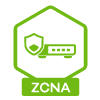[ATP/FLEX]All the options in the WAN interface configuration
 Zyxel Employee
Zyxel Employee



This article explains all the options settings in WAN interface configuration:
Port group | Select the name of the port group to which you want the interface to (network) belong. |
|---|---|
SNAT | Select this to enable SNAT. When enabled, the Nebula Device rewrites the source address of packets being sent from this interface to the interface's IP address. |
VLAN ID | Enter the VLAN ID. This 12-bit number uniquely identifies each VLAN. Allowed values are 1 – 4094. (0 and 4095 are reserved.) |
Type | Select the type of interface to create. DHCP: The interface will automatically get an IP address and other network settings from a DHCP server. Static: You must manually configure an IP address and other network settings for the interface. PPPoE: The interface will authenticate with an Internet Service Provider, and then automatically get an IP address from the ISP's DHCP server. You can use this type of interface to connect to a DSL modem. PPPoE with static IP: Assign a static IP address to the WAN interface and your WAN interface is getting an Internet connection from a PPPoE server. |
IP address assignment | These fields are displayed if you select Static. |
IP address | Enter the static IP address of this interface. |
Subnet mask | Enter the subnet mask for this interface’s IP address. |
Default gateway | Enter the IP address of the Nebula Device through which this interface sends traffic. |
First DNS server | Enter a DNS server's IP address.The Domain Name System (DNS) maps a domain name to an IP address and vice versa. The Nebula Device uses the first and second DNS servers, in that order to resolve domain names for VPN, DDNS and the time server. Leave the field blank if you do not want to configure DNS servers. |
Second DNS server | Enter the IP address of another DNS server. This field is optional. |
These fields are displayed if you selected PPPoE or PPPoE with static IP. | |
Authentication Type | Select an authentication protocol for outgoing connection requests. Options are: •Chap/PAP – The Nebula Device accepts either CHAP or PAP when requested by the remote node. •Chap – The Nebula Device accepts CHAP only. •PAP – The Nebula Device accepts PAP only. •MSCHAP – The Nebula Device accepts MSCHAP only. •MSCHAP-V2 – The Nebula Device accepts MSCHAP-V2 only. |
Username | Enter the user name provided by your ISP. You can use up to 31 alphanumeric characters and the underscore. Spaces are not allowed. |
Password | Enter the password provided by your ISP. You can use up to 64 alphanumeric characters and the underscore. Spaces are not allowed. |
Retype password | Enter the password again to confirm it. |
Downstream bandwidth | Enter the downstream bandwidth of the WAN connection. This value is used for WAN load balancing by algorithms such as weighed round robin. |
Upstream bandwidth | Enter the upstream bandwidth of the WAN connection. This value is used for WAN load balancing by algorithms such as weighed round robin. |
MTU | Maximum Transmission Unit. Enter the maximum size of each data packet, in bytes, that can move through this interface. If a larger packet arrives, the Nebula Device divides it into smaller fragments. Allowed values are 576 – 1500. |
ADVANCED OPTIONS | |
Connectivity check | The interface can periodically check whether it can connect to its default gateway (Default gateway), or to two user-specified servers (Check the two addresses below). If the check fails, the interface's status changes to Down.You specify how often the interface checks the connection, how long to wait for a response before the attempt is a failure, and how many consecutive failures are required before the Nebula Device stops routing to the gateway. |
Probe Succeeds When | This field applies when you select Check the two addresses and specify two domain names or IP addresses for the connectivity check.Select any one if you want the check to pass if at least one of the domain names or IP addresses responds.Select all if you want the check to pass only if both domain names or IP addresses respond. |
Proxy ARP | Proxy ARP (RFC 1027) allows the Nebula Device to answer external interface ARP requests on behalf of a device on its internal interface.Click Add new to add the IP address or IP range of devices that the interface will answer proxy ARP requests for. |
IP Address | Enter a single IPv4 address, an IPv4 CIDR (for example, 192.168.1.1/24) or an IPv4 Range (for example, 192.168.1.2–192.168.1.100).The Nebula Device answers external ARP requests if they match one of these target IP addresses. For example, if the IPv4 address is 192.168.1.5, then the Nebula Device will answer ARP requests coming from the WAN only if it contains 192.168.1.5 as the target IP address. |
Click the remove icon to delete the proxy ARP IP address. | |
MAC address Setting | Have the interface use either the factory-assigned default MAC address, or a manually specified MAC address. |
DHCP client mode | Choices are Auto, Unicast and Broadcast. |
DHCP option 60 | DHCP Option 60 is used by the Security Firewall for identification to the DHCP server using the VCI (Vendor Class Identifier) on the DHCP server. The Nebula Device adds it in the initial DHCP discovery message that a DHCP client broadcasts in search of an IP address. The DHCP server can assign different IP addresses or options to clients with the specific VCI or reject the request from clients without the specific VCI.Enter a string using up to 63 of these characters [a–z A–Z 0–9 !\"#$%&\'()*+,-./:;<=>?@\[\\\]^_`{}] to identify this Nebula Device to the DHCP server. For example, Zyxel-TW. |
IGMP proxy | Select this to allow the Nebula Device to act as an IGMP proxy for hosts connected on the IGMP downstream interface. |
IGMP Upstream | Enable IGMP Upstream on the interface which connects to a router running IGMP that is closer to the multicast server. |
IGMP Downstream | Enable IGMP Downstream on the interface which connects to the multicast hosts. |
Close | Click Close to exit this screen without saving. |
OK | Click OK to save your changes. |
You can visit online help guide to obtain more information
Categories
- All Categories
- 441 Beta Program
- 2.9K Nebula
- 208 Nebula Ideas
- 127 Nebula Status and Incidents
- 6.4K Security
- 528 USG FLEX H Series
- 331 Security Ideas
- 1.7K Switch
- 84 Switch Ideas
- 1.3K Wireless
- 50 Wireless Ideas
- 6.9K Consumer Product
- 293 Service & License
- 462 News and Release
- 90 Security Advisories
- 31 Education Center
- 10 [Campaign] Zyxel Network Detective
- 4.7K FAQ
- 34 Documents
- 86 About Community
- 99 Security Highlight
